Over the last few years, there has been a significant increase in demand for high-quality software and the robustness of the systems. In the current business climate, enterprises are expected to deliver software products as quickly as possible. However, this accelerated development invariably leads to other issues, such as high security risks that can jeopardize the entire system. Traditional development practices aimed to address the speed and security issues faced by all organizations. To overcome the issue of implementing security procedures and turnaround time agility, two models were proposed: DevOps and DevSecOps.
DevOps emphasizes optimizing the entire software development and operational lifecycle to deploy the product rapidly. In contrast, DevSecOps involves integrating security patches into the DevOps pipeline, ensuring that security is prioritized upfront and maintained throughout the development cycle. In this post, we will examine the core functions of DevOps and DevSecOps, their definitions, and the benefits they offer. We will also discuss the fundamental similarities and disadvantages to help you decide which one best suits your needs.
What is DevOps vs. DevSecOps: Benefits, Similarities & Differences
According to Forrester’s Technology and Security 2025 report, it is predicted that security decision-makers will witness a 75% increase in technical debt to a moderate or high level of security by 2026, due to the rapid development of AI solutions. DevOps and professionals must regularly stay aware of and adapt to new trends in technology to remain relevant and competitive.
DevSecOps is all about filling the gaps in security left by DevOps, leveraging the same rapid advancements in technology. Read this guide to understand the similarities, differences between DevOps vs. DevSecOps, along with their benefits.
| Benefit | DevOps | DevSecOps |
|---|---|---|
| Faster delivery cycles | ✅ Yes | ✅ Yes |
| Enhanced team collaboration | ✅ Dev + Ops | ✅ Dev + Sec + Ops |
| Automated workflows | ✅ CI/CD, testing, deployment | ✅ CI/CD + Security scanning |
| Scalability | ✅ Easily scalable pipeline | ✅ Scalable with secure coding practices |
| Early vulnerability detection | ❌ Typically post-deployment | ✅ Integrated during development |
| Risk mitigation | ⚠️ Less emphasis on security | ✅ Prioritized through continuous security audits |
| Regulatory compliance | ❌ May require separate tools | ✅ Built-in security checks for compliance |
What Is DevOps?
DevOps development evolves as different industries continuously develop and emerge. In the past, it was primarily just development and operations, with little consideration given to security. Every company faced the same predicament: rushing to build and deploy applications, only to add security measures later. The DevOps approach focuses on innovation, optimizing resource utilization, accelerating production, and minimizing waste.
The core elements that make DevOps work include:
- Continuous integration and deployment (CI/CD)
- Infrastructure as code (IaC) automates systems, reducing the need for tedious manual setup.
- Eliminating cross-department blaming each other for lack of progress through cross-functional collaboration
- Active issue identification and fixing with relentless automation and monitoring.
Benefits of DevOps
As per the Research and Market statistics report, the DevOps market was valued at $13.6 billion in 2024, which is estimated to reach $81.14 billion by the end of 2033, with a CAGR of 19.95% during the forecast period (2025 – 2033). Moreover, the Atlassian team discovered that businesses that embrace DevOps are more productive, with higher-quality work products, improved deployment times, and increased frequency in the market.
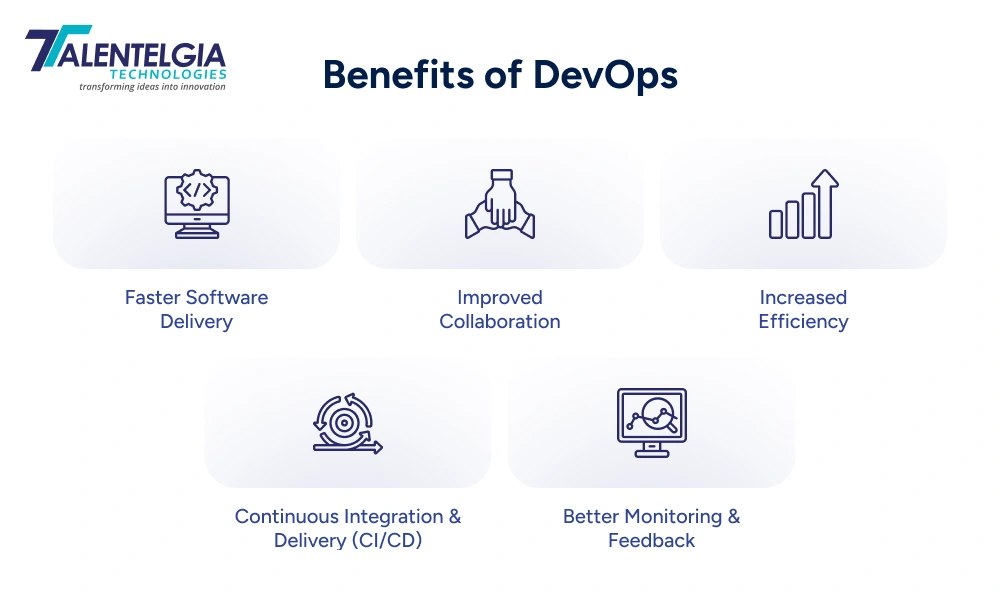
- Faster Software Delivery: Enhances the speed of software development, improvement cycles, and releases, which improves time-to-market.
- Improved Collaboration: bridged the gap between development, operations, and other teams, promoting collaboration and shared objectives.
- Increased Efficiency: Enhances workflows by automating manual tasks and optimizing resource utilization.
- Continuous Integration and Delivery (CI/CD): Simplifies software integration and deployment, enabling faster updates and improvements.
- Better Monitoring and Feedback: Provides real-time feedback and monitoring, offering insights into current issues for proactive resolution and improvement.
What Is DevSecOps?
The evolution of secure software development practices is best encapsulated by the term DevSecOps. With a faster pace and demand for agility, there’s a need to reevaluate how we facilitate security in every phase of the software development life cycle (SDLC). With DevSecOps, security needs are incorporated from the very first steps of development. The software delivery process is both integrated and secure. It automates security checks, meets the best industry standards, and fosters a culture that is conscious of cybersecurity.
Every person, regardless of their role, enhances security by making integrations at all levels and improves customer experience through product value.
When everything is working well with DevSecOps, you will notice:
- Tools to enforce security policies are integrated within the CI/CD pipelines.
- Vulnerability scanning with every new commit.
- Developers know how to write secure code.
- Cross-functional teams of security, development, and operations are cohesive and collaborative.
Benefits of DevSecOps
Overall, internet users (or individuals using applications) have become much more conscious of issues surrounding information security, which is certainly a positive trend. This is rapidly becoming the case among non-technical users and those with practical or theoretical knowledge related to development and digital processes.
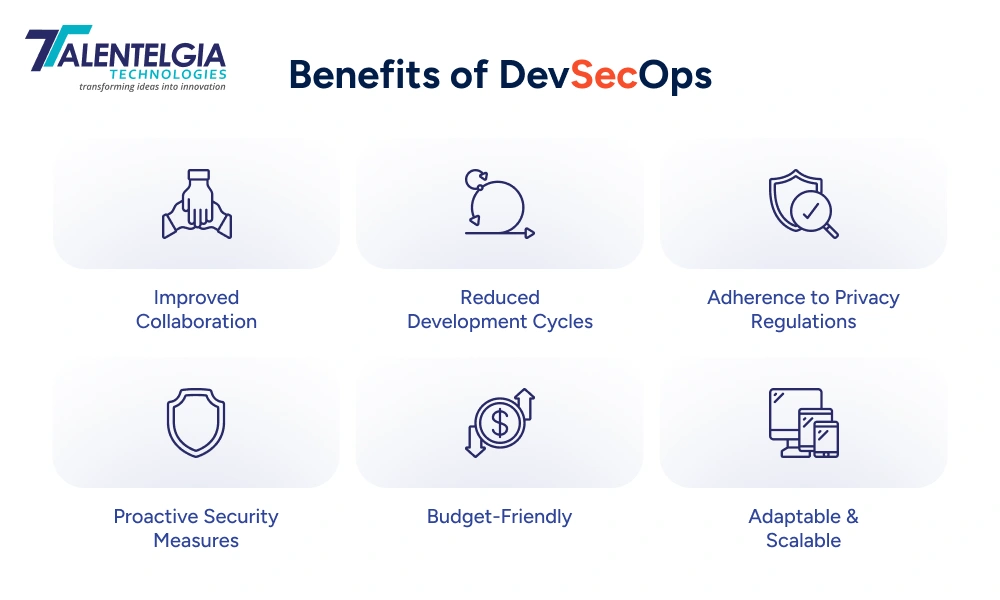
- Improved Collaboration: The same principle applies to DevSecOps and DevOps. It eliminates silos and requires team members from different departments to work together constructively, transforming team collaboration into shared responsibility for the product.
- Reduced Development Cycles: Development times are shortened as automation tools are heavily utilized. It also guarantees compliance with standards such as MISRA and AUTOSAR.
- Adherence to Privacy Regulations: With a focus on security, any software developed using DevSecOps is ensured to comply with privacy regulations such as HIPAA and GDPR.
- Proactive Security Measures: A software perspective that prioritizes security ensures that such software can be built and protected against the OWASP Top 10 web application security risks, maintain PCI DSS data privacy standards, and avoid prevalent and critical oversights, gaps, or loopholes.
- Budget-Friendly: Preventing large and complex bugs from escaping into production reduces the overall costs associated with post-release security breaches and repairs.
- Adaptable & Scalable: Provided you possess the right tools and the ability to optimize your CI/CD pipelines continually, you can access the long-term benefits that DecSecOps offers. These advantages are not short-lived.
Key Differences Between DevOps vs DevSecOps
Conceptually, at the core, DevOps and DevSecOps are the same concept. However, there are some key differences between the two approaches:
| Aspect | DevOps | DevSecOps | Key Difference |
|---|---|---|---|
| Core Focus | Development + Operations | Development + Security + Operations | DevSecOps integrates security as a core component |
| Security Involvement | Introduced later in the pipeline | Embedded from the start | DevSecOps shifts security left into the development phase |
| Team Structure | Developers and Operations | Developers, Security, and Operations | Security becomes a shared responsibility in DevSecOps |
| Tools Used | CI/CD, monitoring, infrastructure automation | CI/CD + static/dynamic code analysis, threat modeling | DevSecOps includes security-focused tools |
| Compliance & Risk Handling | Often handled externally or post-release | Built-in compliance checks and audits | DevSecOps supports regulatory requirements more proactively |
| Security Ownership | Mostly the security team or the post-production audit | Everyone in the pipeline (Dev, Sec, Ops) | DevSecOps fosters a security-first culture |
| Development Speed Impact | Prioritizes speed, may overlook vulnerabilities | Slightly slower, but secure and compliant | Security integrations can add minimal latency for greater safety |
| Threat Detection | After release or during testing | Early detection with automated scans | DevSecOps focuses on prevention, not just mitigation |
| Mindset & Culture | Deliver fast and often | Deliver fast, securely, and with shared trust | DevSecOps builds a proactive security mindset |
Key Similarities Between DevOps vs DevSecOps
While DevOps and DevSecOps have some differences, they share several key similarities. The table below showcases some significant similarities between DevOps and DevSecOps.
| Aspect | DevOps | DevSecOps | Key Similarities |
|---|---|---|---|
| Goal | Faster, reliable software delivery | Secure, faster, reliable software delivery | Both aim to deliver high-quality software quickly |
| Automation Focus | Automates CI/CD pipelines | Automates CI/CD + security integrations | Heavy reliance on automation for efficiency |
| Agile & Iterative Process | Supports agile, iterative development | Supports agile, iterative development | Embraces agile principles for continuous improvement |
| Collaboration Culture | Encourages Dev + Ops collaboration | Encourages Dev + Sec + Ops collaboration | Cross-functional collaboration is essential in both |
| Continuous Integration/Delivery | Core to the workflow | Core to the workflow | CI/CD pipelines drive rapid delivery in both |
| Monitoring & Feedback | Continuous monitoring & feedback loops | Same with added security feedback | Promotes rapid issue detection and response |
| Toolchain Integration | Uses various DevOps tools | Uses similar tools with security layers | DevSecOps often builds on DevOps toolchains |
DevOps or DevSecOps: Which One’s Right For You?
The decision to choose between DevOps and DevSecOps frameworks ultimately comes down to what your business needs most. Simply put, a security component is integrated into the DevOps process. DevSecOps does not replace DevOps— in fact, it enhances the processes and framework of DevOps to provide more secure and high-quality software products.
- DevSecOps focuses on application security, application quality, application functionality, and user interface (UI) design.
- The philosophy of DevSecOps is to integrate the best aspects of DevOps and apply them to security provisions.
- To put it differently, the rest of the team can be integrated into a model of work that is both collaborative and automated, where all security aspects are determined before development commences.
- As with DevOps, the objective is to identify and neutralize security issues before they escalate and become entrenched within critical components of the application, making them incredibly difficult to eradicate.
Select the approach that best aligns with your objectives and integrates seamlessly into your software development lifecycle. Consider your security requirements, the reasons for wanting to work together, and how critical speed vs. security is to you when choosing the best option for your company.
The Bottom Line
DevSecOps is not mere hype. As digital experiences are crucial for achieving business success, there is no longer a compromise between speed and security. Industry leaders today are not deciding to ‘go fast’ or ‘be secure’ — they’re creating fully integrated systems that perform both simultaneously.
However, this shift is not as simple as enhancing the existing toolset. It requires careful planning, internal team collaboration, risk assessment frameworks, and the integration of performance and security metrics in the context of agile systems that are robust and fast.
Do you want to see how Talentelgia Technologies helps the leading organizations identify security vulnerabilities before they harm your system? Schedule a call today!


 Healthcare App Development Services
Healthcare App Development Services
 Real Estate Web Development Services
Real Estate Web Development Services
 E-Commerce App Development Services
E-Commerce App Development Services E-Commerce Web Development Services
E-Commerce Web Development Services Blockchain E-commerce Development Company
Blockchain E-commerce Development Company
 Fintech App Development Services
Fintech App Development Services Fintech Web Development
Fintech Web Development Blockchain Fintech Development Company
Blockchain Fintech Development Company
 E-Learning App Development Services
E-Learning App Development Services
 Restaurant App Development Company
Restaurant App Development Company
 Mobile Game Development Company
Mobile Game Development Company
 Travel App Development Company
Travel App Development Company
 Automotive Web Design
Automotive Web Design
 AI Traffic Management System
AI Traffic Management System
 AI Inventory Management Software
AI Inventory Management Software
 AI Software Development
AI Software Development  AI Development Company
AI Development Company  AI App Development Services
AI App Development Services  ChatGPT integration services
ChatGPT integration services  AI Integration Services
AI Integration Services  Generative AI Development Services
Generative AI Development Services  Natural Language Processing Company
Natural Language Processing Company Machine Learning Development
Machine Learning Development  Machine learning consulting services
Machine learning consulting services  Blockchain Development
Blockchain Development  Blockchain Software Development
Blockchain Software Development  Smart Contract Development Company
Smart Contract Development Company  NFT Marketplace Development Services
NFT Marketplace Development Services  Asset Tokenization Company
Asset Tokenization Company DeFi Wallet Development Company
DeFi Wallet Development Company Mobile App Development
Mobile App Development  IOS App Development
IOS App Development  Android App Development
Android App Development  Cross-Platform App Development
Cross-Platform App Development  Augmented Reality (AR) App Development
Augmented Reality (AR) App Development  Virtual Reality (VR) App Development
Virtual Reality (VR) App Development  Web App Development
Web App Development  SaaS App Development
SaaS App Development Flutter
Flutter  React Native
React Native  Swift (IOS)
Swift (IOS)  Kotlin (Android)
Kotlin (Android)  Mean Stack Development
Mean Stack Development  AngularJS Development
AngularJS Development  MongoDB Development
MongoDB Development  Nodejs Development
Nodejs Development  Database Development
Database Development Ruby on Rails Development
Ruby on Rails Development Expressjs Development
Expressjs Development  Full Stack Development
Full Stack Development  Web Development Services
Web Development Services  Laravel Development
Laravel Development  LAMP Development
LAMP Development  Custom PHP Development
Custom PHP Development  .Net Development
.Net Development  User Experience Design Services
User Experience Design Services  User Interface Design Services
User Interface Design Services  Automated Testing
Automated Testing  Manual Testing
Manual Testing  Digital Marketing Services
Digital Marketing Services 
 Ride-Sharing And Taxi Services
Ride-Sharing And Taxi Services Food Delivery Services
Food Delivery Services Grocery Delivery Services
Grocery Delivery Services Transportation And Logistics
Transportation And Logistics Car Wash App
Car Wash App Home Services App
Home Services App ERP Development Services
ERP Development Services CMS Development Services
CMS Development Services LMS Development
LMS Development CRM Development
CRM Development DevOps Development Services
DevOps Development Services AI Business Solutions
AI Business Solutions AI Cloud Solutions
AI Cloud Solutions AI Chatbot Development
AI Chatbot Development API Development
API Development Blockchain Product Development
Blockchain Product Development Cryptocurrency Wallet Development
Cryptocurrency Wallet Development About Talentelgia
About Talentelgia  Our Team
Our Team  Our Culture
Our Culture 
 Healthcare App Development Services
Healthcare App Development Services Real Estate Web Development Services
Real Estate Web Development Services E-Commerce App Development Services
E-Commerce App Development Services E-Commerce Web Development Services
E-Commerce Web Development Services Blockchain E-commerce
Development Company
Blockchain E-commerce
Development Company Fintech App Development Services
Fintech App Development Services Finance Web Development
Finance Web Development Blockchain Fintech
Development Company
Blockchain Fintech
Development Company E-Learning App Development Services
E-Learning App Development Services Restaurant App Development Company
Restaurant App Development Company Mobile Game Development Company
Mobile Game Development Company Travel App Development Company
Travel App Development Company Automotive Web Design
Automotive Web Design AI Traffic Management System
AI Traffic Management System AI Inventory Management Software
AI Inventory Management Software AI Software Development
AI Software Development AI Development Company
AI Development Company ChatGPT integration services
ChatGPT integration services AI Integration Services
AI Integration Services Machine Learning Development
Machine Learning Development Machine learning consulting services
Machine learning consulting services Blockchain Development
Blockchain Development Blockchain Software Development
Blockchain Software Development Smart contract development company
Smart contract development company NFT marketplace development services
NFT marketplace development services IOS App Development
IOS App Development Android App Development
Android App Development Cross-Platform App Development
Cross-Platform App Development Augmented Reality (AR) App
Development
Augmented Reality (AR) App
Development Virtual Reality (VR) App Development
Virtual Reality (VR) App Development Web App Development
Web App Development Flutter
Flutter React
Native
React
Native Swift
(IOS)
Swift
(IOS) Kotlin (Android)
Kotlin (Android) MEAN Stack Development
MEAN Stack Development AngularJS Development
AngularJS Development MongoDB Development
MongoDB Development Nodejs Development
Nodejs Development Database development services
Database development services Ruby on Rails Development services
Ruby on Rails Development services Expressjs Development
Expressjs Development Full Stack Development
Full Stack Development Web Development Services
Web Development Services Laravel Development
Laravel Development LAMP
Development
LAMP
Development Custom PHP Development
Custom PHP Development User Experience Design Services
User Experience Design Services User Interface Design Services
User Interface Design Services Automated Testing
Automated Testing Manual
Testing
Manual
Testing About Talentelgia
About Talentelgia Our Team
Our Team Our Culture
Our Culture
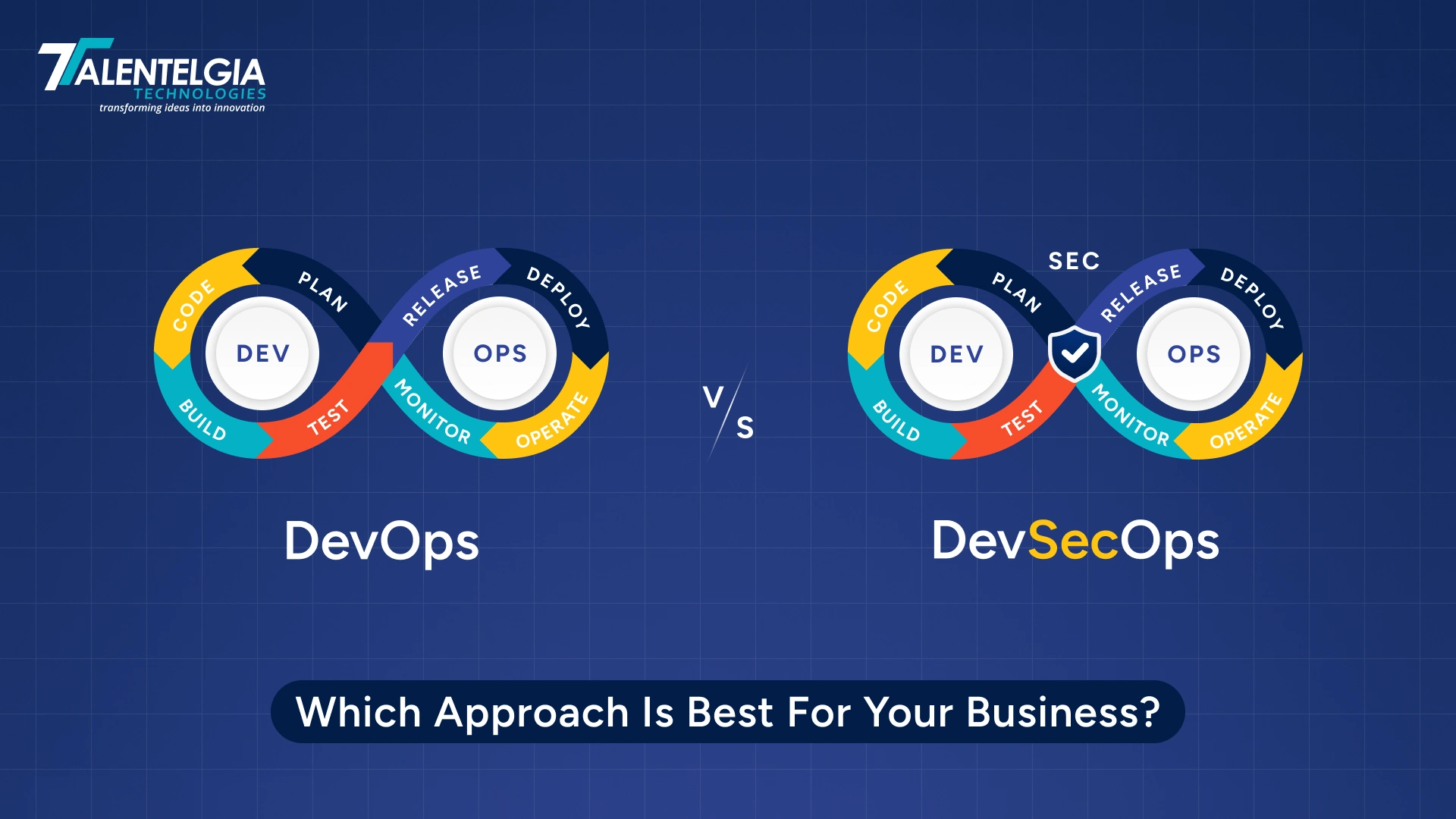

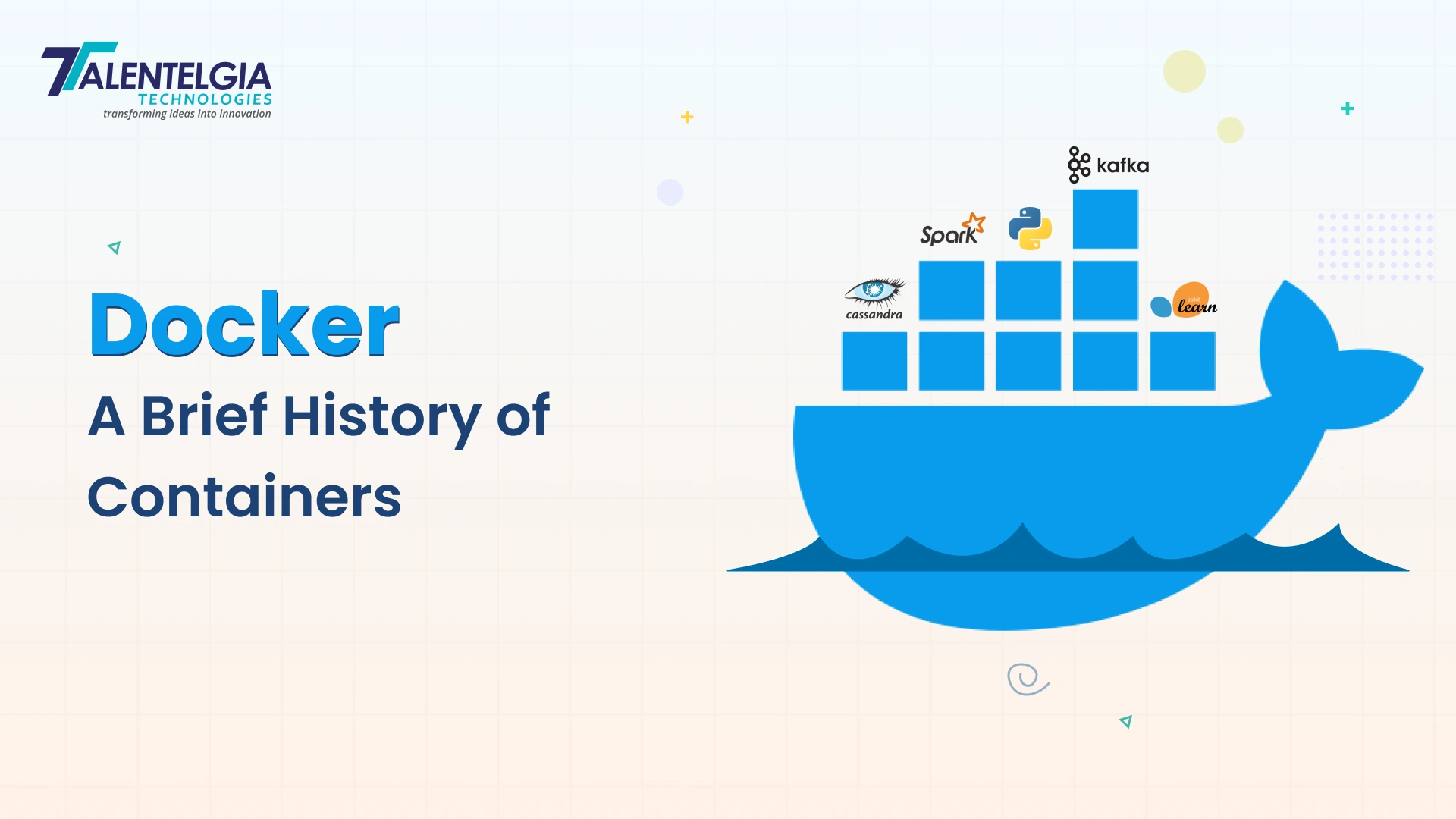













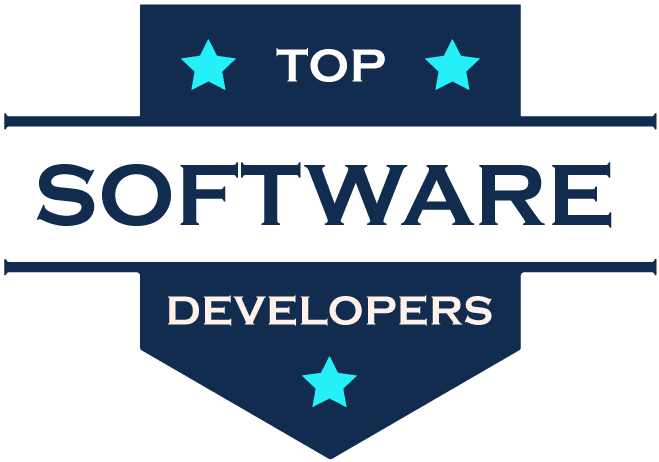
 Write us on:
Write us on:  Business queries:
Business queries:  HR:
HR: 




